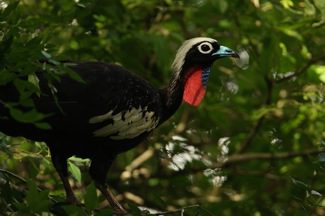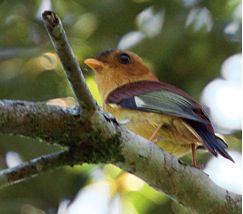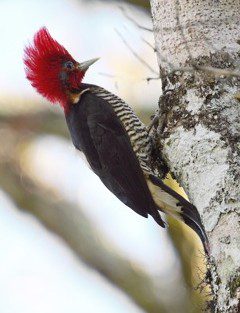From Brazil: Round Table on Endangered Atlantic Forest Birds
By Martjan Lammertink August 26, 2010
Several of our staff are spending the week in Brazil, at the 25th International Ornithological Congress. Kind of like a larger, more global AOU meeting, these conferences began in 1884 and are held every four years.
Here’s an update from Dr. Martjan Lammertink, a research associate at the Cornell Lab, an expert on the world’s large woodpeckers, and a veteran of rainforest fieldwork on at least three continents. Last night, he attended a meeting of scientists hoping to save the unique birds of the Atlantic Forest of Brazil, Paraguay, and Argentina:
In some ways, the small conference room all 40 of us packed into was appropriate: The Atlantic Forest of southeastern South America is full of species that occur nowhere else—and because of deforestation, they now have only 12 percent of the forest’s original area to live in. Many are threatened with extinction, and meeting organizers Kristina Cockle and Alberto Esquivel had convened us here to discuss how best to conserve their populations.
We quickly honed in on the one species that participants agreed is the Atlantic Forest’s most endangered species: the Purple-winged Ground-Dove (Claravis godefrida). These birds once occurred in nomadic groups of more than 100, and until a few decades ago they were a common cage bird, but in recent decades it has become extremely rare. Only two people in the room had ever seen this ground-dove, and the bird’s global population is estimated at about 250.
Like some other ground-doves, this species has been thought to follow mass flowerings of a kind of bamboo (in the genus Guadua), although one recent sighting was outside of bamboo. Fragmentation of the Atlantic Forest likely impedes these movements and this probably is the main cause of the species’ decline. Participants agreed that a priority should be the quick notification of bamboo flowerings to ornithologists and birders active in the region so that they can search for the ground-dove in these settings. A major hindrance in surveys for Purple-winged Ground-Dove is that the voice of this bird is unrecorded. Participants recommended interviewing bird trappers in Brazil that used to catch the species until about 20 years ago, to get at least an oral description of the vocalizations of the species, and other insights into its biology.

Like some other ground-doves, this species has been thought to follow mass flowerings of a kind of bamboo (in the genus Guadua), although one recent sighting was outside of bamboo. Fragmentation of the Atlantic Forest likely impedes these movements and this probably is the main cause of the species’ decline. Participants agreed that a priority should be the quick notification of bamboo flowerings to ornithologists and birders active in the region so that they can search for the ground-dove in these settings. A major hindrance in surveys for Purple-winged Ground-Dove is that the voice of this bird is unrecorded. Participants recommended interviewing bird trappers in Brazil that used to catch the species until about 20 years ago, to get at least an oral description of the vocalizations of the species, and other insights into its biology.
Discussions moved on to other threatened species as participants traded notes on the biology of these species among the three Atlantic Forest countries. In Brazil, including around Campos do Jordão, where we were meeting, the Black-capped Piprites (Piprites pileata) occurs in the midstory of forests, sometimes among paraná pines (Araucaria angustifolia). Here it migrates up and down slope between seasons, but in Argentina extensive searches have revealed only seven territories, and these were all in riverside forests with laurel layana (Ocotea pulchella), and on at least one of these the birds stayed year-round.
The White-bearded Antshrike (Biatas nigropectus) is closely tied to Guadua bamboo in Argentina. This bamboo is tall, with large stems. Reports from Brazil have suggested it uses a smaller bamboo (Merostachys), but Brazilian participants corrected this picture and confirmed that in Brazil Guadua bamboo was the habitat to search for this bird.
Paraguayan participants remarked on the high rate of capture of parrot chicks (Vinaceous Amazons, Amazona vinacea) by settlers around the Itaipu reserves, whereas the problem seems much less severe in Argentina because of environmental education. The species appears to be found in highest numbers in the Brazilian state of Paraná.

The flamboyantly coiffed Helmeted Woodpecker (Dryocopus galeatus) only occurs in or near mature and well-protected forests, and despite a recent increase in known occupied sites it remains a rare and vulnerable species throughout its range.
By 10 p.m., we had all agreed that Atlantic Forest birds need to be better known, not just in terms of distribution and conservation, but their ecology as well, so we can understand how to improve their situations. We will also need to study variation in how these birds live in different parts of their Atlantic Forest range—and that will require making data available between countries. The creation of an online forum is a high priority and a low cost first step. With continued cooperation, we may give these unique birds a better chance in the future. For tonight, we went our own ways, reflecting on new insights and eager to enjoy seeing more Atlantic Forest birds in the vicinity of Campos do Jordão in the coming days.

All About Birds
is a free resource
Available for everyone,
funded by donors like you
American Kestrel by Blair Dudeck / Macaulay Library
